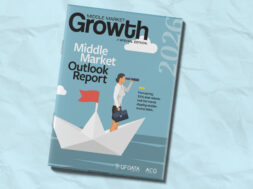A Tailored Approach to Funding Women- and BIPOC-Owned Businesses
Anne Richie discusses her approach to connecting minority-owned businesses with the capital they need to succeed

During her experience in banking and finance at Goldman Sachs, ACR Capital and other firms, Anne Richie came to recognize an injustice: Women and people of color experience a “glaring” discrepancy in the amount and types of capital they are able to secure from investors, compared to other demographics of business owners.
That observation led Richie to her current role as managing director of The Mezzanine Fund, an investment firm designed to tailor capital deployment based on the needs and challenges of women- and BIPOC-owned businesses.
Speaking with Middle Market Growth, she offers insight into what those challenges are, and explains why she’s optimistic about the state of diversity and inclusion in today’s funding environment.
Q: Can you tell us a bit about your background, as well as some insight into The Mezzanine Fund?
A: My experience as a capital provider has been with high-risk capital only, and with companies at opposite stages of the business lifecycle. I am a former workout banker, having spent 15-plus years managing portfolios of distressed debt with extensive experience in capital restructurings, bankruptcies, liquidations and secondary market loan sales.
After leaving banking, I spent four years as a chief financial officer and chief restructuring officer for an aerospace parts manufacturer that was acquired from TRW by private equity. Most recently, I was a venture partner investing in technology businesses across three funds.
The concept of The Mezzanine Fund emerged from my observations of the glaring discrepancies in the amounts, type, terms and cost of capital that is deployed to women and people of color versus other capital seekers. The fund provides debt capital to lower middle-market companies owned by women and people of color using a builder capital model. [Editor’s note: the builder capital model is deployed by The Builder Capitalist, an organization of which The Mezzanine Fund is a founding member.]
The concept of The Mezzanine Fund emerged from my observations of the glaring discrepancies in the amounts, type, terms and cost of capital that is deployed to women and people of color versus other capital seekers.
Builder capital aligns the interests of fund investors and portfolio companies to maximize value, without pressure for valuation targets, predetermined exits and hyper-accelerated growth. Builder capital is especially effective in creating wealth as it preserves ownership and supports long-term growth, sustainability and legacy. Value is achieved through innovation versus financial engineering. The mission of The Mezzanine Fund is to unleash the innovation and outperformance of the underserved.
Related content: How to Measure the Impact of Impact Investing
Q: What are some unique challenges or considerations to capital structure when focusing on funding middle-market businesses owned by women and people of color?
A: The unique challenges and considerations related to capital structuring for middle-market businesses owned by women and people of color are circular and as such, self-perpetuating.
Some of the challenges are:
-
- Concentration in low-margin, lower growth industries. Due in part to limited access to capital and lack of participation in certain occupations, women and people of color compete disproportionately in low-margin, hyper-local, lower growth industries, focused more on retail rather than wholesale, distribution and manufacturing business models. The challenge is that these industries are less attractive to capital providers in general and attract less capital.
- Supplier diversity certification requirements. Middle-market companies owned by women or people of color that sell B2B are often encouraged to participate in corporate supplier diversity programs that require that 51% ownership be certified and maintained. The challenge is that this requirement restricts potential growth from external equity investments, reduces exit opportunities due to a smaller population of potential buyers that can maintain the certification, and can reduce valuations because of the perceived risk that loss of the certification could result in loss of customers and revenue.
- Sub-optimal capital structures due to bias in underwriting. The well-documented access-to-capital gap results in businesses owned by women and people of color paying more for capital with inferior terms, or accessing capital that has geographic, employee retention or social mission covenants or requirements. The challenge is that these special programs sometimes result in sub-optimal capital structures that can be difficult to refinance on market terms, and they can also skew the risk profile and risk assessment of the business.
Q: Scaling a business is important for any owner. What is your take on how to scale a woman- or BIPOC-owned business?
A: To scale organically, woman- and BIPOC-owned businesses can secure enterprise customer relationships wherein they provide products and services that are core to their customers’ business. This may require expanding their product and service offering and venturing into new industries.
To scale through acquisitions, women and people of color can build networks that provide proprietary access to opportunities for a merger, spin-off, acquisition and joint venture. These networks have historically not included women and people of color, yet they are the source of transactions that are not widely marketed.
Lastly, women and people of color can lean into the behaviors that have resulted in their well-researched outperformance, including innovative thinking, relationship-building, creativity and diversity.
Related content: Portfolio Company CEOs Are Focused on DEI, but Lack a Clear Path Forward
Q: What does today’s funding landscape look like in terms of available capital for middle-market businesses in this demographic?
A: The funding landscape for businesses owned by women and people of color is broader than I have ever witnessed in my entire career in finance. This is in large part due to the recognition and acknowledgement of significant historic bias and the good intentions of those with capital to fix the bias.
The funding landscape for businesses owned by women and people of color is broader than I have ever witnessed in my entire career in finance.
There has been an unprecedented number of announcements of new funding vehicles and models in venture, community development financial institutions, and growth and impact funds, as well as initiatives within commercial banks and the philanthropic community. It will be critical, however, that there are diverse individuals deploying the capital, accountability and strategic guardrails that ensure that there are equitable outcomes. Pouring more capital through a broken system will not close access to capital or racial wealth gaps.


